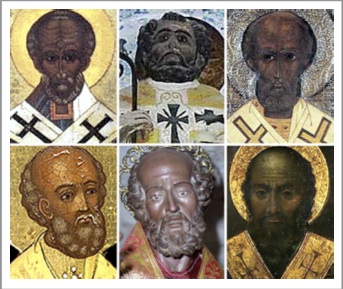
Was the real Santa Claus black?!
The Dutch have been getting their knickers in a twist these days about the skin colour of Zwarte Piet (Black Pete), Sinterklaas’s helper. But perhaps the commotion is all about the wrong person. For the earliest icons of Sint Nicolas or Sinterklaas, the origin of Santa Claus, suggest that he was the black man. Maybe we’ve had it wrong all these centuries!
All these mythical figures stem from a man who actually once lived in ancient Myra, today’s Demre, in south-west Turkey–not Spain or the North Pole. OK, never let truth get in the way of a good story, they say. But it’s worth putting the record straight.
My wife and I happen to be in Turkey right now visiting several locations where Paul also passed through, including Myra. On his voyage to Rome, Paul, his fellow prisoners and Julius the centurion set ashore in Myra. There they boarded the Alexandrian ship which later was wrecked on Malta (Acts 27: 5,6). On his third voyage, Paul briefly docked in Patara just west of Myra, heading towards Jerusalem (Acts 21:1).
Patara was where Niko-laos (‘victory of the people’) was born probably late in the third century. Some say he was the son of very wealthy black Anatolians of the ancient Roman Empire. Tradition holds that his parents died in an epidemic while he was young. He seems to have been a believer from a young age and made a pilgrimage to Egypt and Palestine while still a youth.
Back in Myra, he was made bishop of that port city, and soon became widely known for his generosity to the needy, inspired by the teachings of Jesus. One legend says he dropped purses of gold coins down a chimney for the daughters of a poor man who could not afford a dowry. Along with other bishops, Nicolas was imprisoned under Diocletion’s persecution of Christians around 303AD. Released after Constantine became emperor, he is said to have attended the historic Nicene Council in 325.
Relics
The Feast of St Nicolas marks the day he died in Myra, December 6, AD 343. Hence in the Netherlands Sinterklaas is celebrated annually with the giving of gifts on the night before and on the next morning in Belgium, Luxembourg, and Northern France (French Flanders, Lorraine and Artois). He is also well known in parts of Germany and Austria (Sankt Nikolaus); Switzerland (Samichlaus); Italy (San Nicola); Bosnia and Herzegovina, Croatia and Serbia (Sveti Nikola); Slovenia (Sveti Nikolaj or Sveti Miklavž); and Greece (Agios Nikolaos). Many European cities still claim Nicolas as their patron saint: from Amsterdam to Aberdeen, Limerick to Liverpool, Naples to Portsmouth. In fact, he seems to have been everybody’s favourite saint: from merchants and sailors, newly-weds and judges, archers and thieves, children and students to old maids and penitent murderers.
Bari in southern Italy claims a special link wth Nicolas. dating from 1087, when sailors ‘translated’ the body from Byzantine Myra to Italy, against the protests of local Orthodox monks. They believed they were saving the Christian relics from the invading Muslim Seljuk Turks. After all, Nicolas himself had appeared to them in a vision saying he wanted to be laid to rest in Bari. Who could argue against that? The body of Nicolas arrived in Bari amidst great fanfare on May 9 that year. To this day, his arrival is re-enacted with a flotilla of boats, fireworks and a street parade with a life-size St Nicholas. Celebrations climax in the great 12th century Romanesque basilica built to house his relics, where depictions of the saint clearly show Nicolas as black-skinned.
Spain?
So how did our Sinterklaas/Santa Claus/Father Christmas become so pale? And why do Dutch parents tell their children that the Sint comes from Spain? Well, it’s complicated. Probably it has to do with the Spanish empire of Charles V and Philip II absorbing southern Italy–and Bari–thus introducing the feast to the West. Spanish sailors may have introduced the story to the Dutch.
The feast survived the radical changes brought by the Reformation to Amsterdam, and Dutch Protestants settling Nieuw Amsterdam at the mouth of the Hudson River took with them the feast of (an already white) Sinterklaas. When the English took control and the city became New York, the Sint became Santa Claus.
Meanwhile back in Europe, the feast was embellished with elements of the Germanic god Odin, who rode the skies on his white horse. Finishing touches of today’s Santa Claus came when Coca-Cola commissioned Norman Rockwell to create a jolly fat figure dressed in the red-and-white company colours.
All of which is a long way removed from the original godly bishop of Myra whose generosity to the poor and needy was in direct obedience to the teachings and example of his Lord Jesus.
Maybe I’ll write a letter to the mayor of Amsterdam to suggest he set the record straight next year by having a black Sinterklaas ride his horse into the city.
Till next week,
Jeff Fountain

Jeff…great word and in all seriousness do write that letter to the Mayor of Amsterdam. That would be a tremendous way to set the record straight.
Hi Jeff- Good article, but I thought I’d check out the Santa Claus/Coca Cola connection. It wasn’t Norman Rockwell, and the red suit long predated the Coke commercial. Check out Snopes. http://www.snopes.com/holidays/christmas/santa/cocacola.asp
Tim, I did write the mayor. No response yet. 🙂 A black, or at least darker, Sint would be closer to the historical record, as well as to the skin colour of the average Amsterdammer today. It would totally reframe the Zwarte Piet debate eliminating the white supremacy/racist factor.
Ed, thanks for clarifying this misconception about Norman Rockwell and Coca-Cola I have no doubt shared with many others.
Thomas Nast came to mind. I Googled him and found this interesting written piece about Santa Claus: http://www.unmuseum.org/santa.htm.